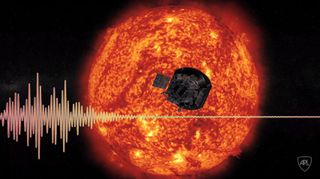NASA's Parker Solar Probe hears whispers of solar wind
Streams of plasma from the sun create "chirping" and "whistling" noises, and NASA's Parker Solar Probe can hear them.
The solar wind is a stream of charged particles released from the sun's upper atmosphere, also known as the corona. This plasma consists of electrons, protons and other charged particles that flow from the sun's atmosphere and out into the solar system at roughly 1 million mph (1.6 million km/h).
Launched in August 2018, NASA's Parker Solar Probe has studied the sun up close since arriving at the star in November 2018. Recent analysis of these observations has revealed small chirps, squeaks and rustles produced by the solar wind, according to a statement from Johns Hopkins Applied Physics Laboratory (APL) in Maryland.
Related: The sun isn't silent — hear its song in new observatory data

"We are looking at the young solar wind being born around the sun," Nour Raouafi, a mission project scientist at APL, said in the statement. "And it's completely different from what we see here near Earth."
Earlier observations of the solar wind have shown that the charged particles don't slow down as they leave the sun; they actually speed up. One of the goals of the Parker Solar Probe is to better understand how exactly the charged particles get accelerated.
Using the probe's Electromagnetic Fields Investigation (FIELDS) instrument, researchers have observed fluctuations in electric and magnetic fields caused by plasma waves within the solar wind streaming from the sun. Scientists think that particles can ride these plasma waves, which, in turn, may propel the particles to higher speeds, according to the statement.
Get the Space.com Newsletter
Breaking space news, the latest updates on rocket launches, skywatching events and more!
Data from the FIELDS instrument showed the frequency and amplitude of interactions between plasma waves and particles, which researchers were then able to turn into audible sound waves.
"Plasma waves certainly play a part in heating and accelerating the particles. Scientists just don’t know how much of a part," Raouafi said in the statement. "We are seeing new, early behaviors of solar plasma we couldn't observe here at Earth, and we're seeing that the energy carried by the waves is being dissipated somewhere along the way, to heat and accelerate the plasma."
The researchers identified several different sound waves in this data. They found that energetic electrons that follow magnetic field lines stretching from the sun out into the solar system create whistler-mode waves when amplified by plasma waves at the same frequency.
Additionally, the researchers found that dispersive plasma waves create a "chirp" sound when they quickly shift from one frequency to another as they move through the solar wind, according to the statement.
The probe also captured static-like sounds as it moved through a cloud of microscopic dust and collided with particles, which burst apart into electrons, protons and other constituent particles upon impact.
"These waves haven't been detected in the solar wind before, at least not in any large numbers," David Malaspina, a member of the FIELDS team and an assistant professor at the Laboratory for Atmospheric and Space Physics at the University of Colorado Boulder, said in the statement. "Nobody knows what causes these chirping waves or what they do to heat and accelerate the solar wind. That's what we're going to be determining."
The Parker Solar Probe is expected to make another 21 orbits around the sun, during which the spacecraft will travel increasingly closer to the star and observe the behavior of the solar wind in greater detail.
- Amazing New Sun Photos from Space
- Video: Sun's Outburst Pointed Almost Directly at Earth
- Photos: Sunspots on Earth's Closest Star
Follow Samantha Mathewson @Sam_Ashley13. Follow us on Twitter @Spacedotcom and on Facebook.

Join our Space Forums to keep talking space on the latest missions, night sky and more! And if you have a news tip, correction or comment, let us know at: community@space.com.

Samantha Mathewson joined Space.com as an intern in the summer of 2016. She received a B.A. in Journalism and Environmental Science at the University of New Haven, in Connecticut. Previously, her work has been published in Nature World News. When not writing or reading about science, Samantha enjoys traveling to new places and taking photos! You can follow her on Twitter @Sam_Ashley13.